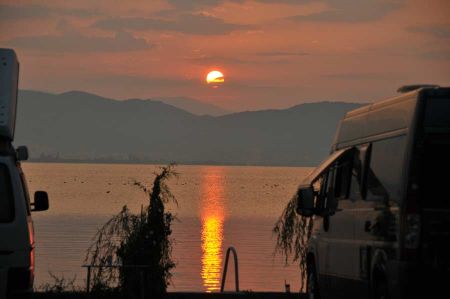The awaking cormorant in the morning light at Lake Ohrid
- Written by Portal Editor
At the sunrise the following morning our first way led to the shore of Lake Ohrid, which always reflects the beautiful sunrise from over the Gilicica National Park.
Just the different voices and sounds of seabirds from the lake were to realize, it is marvelous to observe this unique nature in all its beauty. You are asking, where are we now? Our current where about to continue the project work is once more Camping Rino in Kalishta.
We hope that the region with Lake Ohrid will be able to keep its beauty and finding its way and the planned major construction projects of hotels and highways can be stopped. The vital purification of the seawater will be eliminated quickly, when reed fields on the lake shore will be destroyed. It is paradoxical and technologically absurd to eliminate natural water purification by plants, then add artificial treatment to take over their function. Is this really progress or not more pure, shortsighted greed? In Western Europe the sedge plants for cleaning of grey water perfectly fit by the help of so-called C4 plants (reeds, irises, rushes), just to care and take away the pollution, here these natural reed belt are existing but will be eliminated. Mass tourism, so our experience after many years of traveling and discussing in international tourism, always just brings value to a few large companies, the local residential localities, businesses and tourism providers perish quickly. See Spain, see Turkey. Just sustainable tourism would be a real opportunity for the Ohrid Lake. But now back to Cormorant and Ohrid Lake.
We know some of the species of waterfowl, unfortunately far from all. Thus, it is sometimes difficult to assign species, especially in places that have a wide range of endemic species. The cormorants on Lake Ohrid, although not belonging to the endemic species, are living in, correspondingly large numbers on Lake Ohrid, easy to watch. With its body length from 0.45 to 1.0 meters, weighing 360-2800 grams, cormorants are excellent fishermen among water birds. There are two types of coloring: A number of species is solid black or dark brown, the plumage often, in particular, shines metallic during the breeding season. In the second variation staining only the top is dark, but the bottom white. Two-tone types are more common in the southern hemisphere, largely monochrome on the northern hemisphere.
Cormorants have a long neck and a rather long, wedge-shaped tail. Like some birds living in the water they have an expandable throat pouch to keep the fish before eating. In some countries, cormorants are trained to go fishing for human fisherman fix a cord around their neck, so that birds can just take the fish down into their throat pouch. Lateron fishermen take the fish out. The beak is long, relatively high and at the top sharply bent like a hook. The nostrils are fused. The legs are set far back on the body and allow only a clumsy acting ashore, waddling or bouncing gait. The feet show four toes and are webbed, as is typical for birds living in the water.
In the water cormorants move very agile, the strong feet are used as a drive. When diving both legs are simultaneously and in parallel used as paddles. The wings are usually applied close to the body. The tail serves as a rudder. The dense, little pneumatized skeleton is much heavier than that of the related pelicans. This reduces the lift. So cormorants can reach greater depths quickly and with just little energy. Dives usually last 20 to 40 seconds.
The wings are relatively short, slightly rounded and are usually strongly bent in the wrist during flight. The wing beats are strong and stimulating; Cormorants can circle upwards and slide only under favorable conditions. The flight speed can be up to 80 km / h. For flying up cormorants have to walk a long distance through the water surface before they can withdraw. The landing carried upright, with spread tail and feet outstretched. Cormorants also land on the ground, on tree branches or cliffs.
Among the cormorants there are many endemic species that occur only on small islands, including the flightless Cormorant, the Sokotra Cormorant and Chatham Cormorant; on many sub-Antarctic islands, there are other examples. Other species, however, have extremely large distribution areas, the Common Cormorant is almost a cosmopolitan.
They are found both on sea coasts and inland waters. Some species live exclusively in inland, others exclusively to coastal and other habitats both equally populated. The coastal-dwelling species are always found near the mainland and never on the open sea. Inland, most species prefer flat areas; a notable exception is the Neotropic Cormorant, which is still living even at lakes in 5000 meters above sea level in the Andes.
Maybe you like the pictures of the early morning, so that you even want to visit the Ohrid Lake once. In Ohrid itself, there is an international airport, the accessibility by Camper is easy possible from Croatia, Montenegro and Albania, without any problems. If your interest should be aroused, please visit the Camper-Route.de to see some of the places to have a break.
Please read as well:
Back at Lake Ohrid - Morning impressions at the lake site
Exploration - Paragliding at Struga at Lake Ohrid
-
-
-
-
-
-
-
-
-
-
-
-
https://www.alaturka.info/en/macedonia/struga/3429-the-awaking-cormorant-in-the-morning-light-at-lake-ohrid/amp#sigProIda832f8b96e
